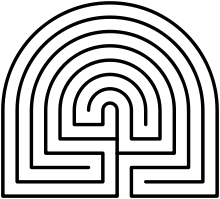Caerdroia

.png)
A caerdroia is a Welsh turf maze, usually in the sevenfold Cretan labyrinth design. They were created by shepherds on hilltops and were apparently the setting for ritual dances, the nature of which have been lost. At the centre of each caerdroia was a small hillock—in Welsh, twmpath. A gathering for folk dancing in Wales is still called a twmpath dawns.
Etymology
Caerdroia is the Welsh name for ancient Troy. Variations include Caer Droia and Caer Droea). Because of the similarity between Welsh troeau (a plural form of tro 'turn') and the second element Troea ('Troy'), the name was later popularly interpreted as meaning 'fortress of turns' (caer = 'fort').
Mythical link
There is another tenuous connection between Wales and Troy that has been disproven by historians but remains a resilient myth. Geoffrey of Monmouth, following the early Welsh historian Nennius, created a Christian/classical genealogy which placed Brutus of Troy, grandson of Aeneas and liberator of enslaved Trojans, as founder of Britain. This Brutus is generally considered a medieval fiction.
See also
Further reading
External links
- W.H. Matthews, Mazes and Labyrinths (1922) online version of W.H. Matthew's classic book
- Labyrinthos Jeff Saward's website
- Labyrinth Society
- The Megalithic Portal
- Labyrinth Locator (Veriditas & Labyrinth Society)
- Well-illustrated labyrinth site (in German)